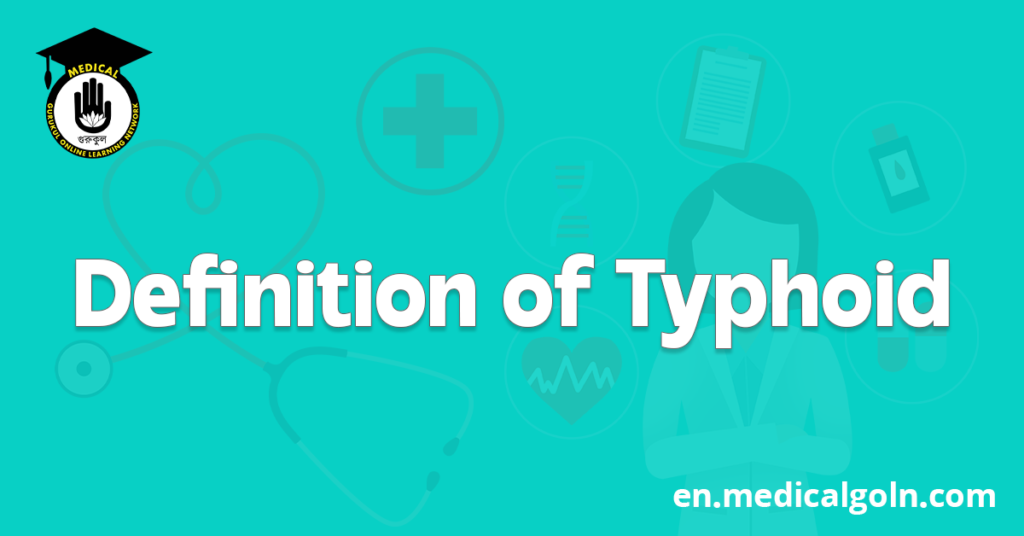Today is our topic of discussion Definition of Typhoid
Definition of Typhoid
Enteric fever:
Any of a group of febrile illnesses associated with enteric symptoms caused by salmonellae, especially typhoid fever and paratyphoid fever. The terms ‘typhoid fever’ and ‘enteric fever’ are used synonymously.
Bangladesh situation:
Typhoid is endemic in Bangladesh. It is the most common cause of febrile illness in the community and also in hospital.
Causative agent:
- Salmonella typhi
- Salmonella paratyphi A and
- Salmonella paratyphi B.
Reservoir of infection:
Man (cases and carriers)
Source of infection:
Stools and urine of cases and carriers
Host factors:
Age:
Commonest ages of victims are 10 to 30 years, though all age groups are susceptible.
Sex:
Cases are more among males but carriers are more in female.
Immunity:
Gastric acidity and local intestinal immunity contribute to resistance.
Environment:
Poor socioeconomic environments with low standard of personal hygiene, non-availability of safe drinking water and inadequate disposal of excreta favour occurrence and transmission of the disease.
Incubation period:
7 to 14 days.
Mode of transmission:
1. Ingestion of water and food contaminated with feces and urine of patients and carriers.
2. Flies may infect foods in which the organisms multiply to achieve an infective dose.
Period of communicability:
As long as bacilli appear in excreta, usually from the first week throughout convalescence. About 10% of untreated patients will discharge bacilli for 3 months after onset of symptoms, and 2%-5% become chronic carriers.
Pathogenesis:
The bacteria get its way into intestine through ingestion of contaminated food and drinks →→ Taken up by Peyer’s patches of terminal ileum → Local lesion or enter into bloodstream.
Clinical feature:
First week:
Onset is insidious and starts with constitutional symptoms, such as, myalgia, fever, relative bradycardia, ch headache, anorexia etc. followed by rise of temperature in a stepladder fashion. Fever may rise up to 39° to 40°C with a typical pattern of ‘double rise’.
End of first week:
Rose spots (blanching and slightly raised macules) on the chest and abdomen along with hepatomegally, splenomegally, diarrhoea, constipation and or abdominal distension.
End of second week:
Neurological manifestations such as, delirium, coma and death ensues or develop complications, if untreated
Complication:
1. Intestine: Ileal perforation and haemorrhage
2. Bone and joint infection, meningitis and cholecystitis
3. Myocarditis
4. Nephritis
Investigation:
1. Blood TC, DC-Leucopenia with relative lymphocytosis
2. Blood culture – Positive in first week.
3. Widal test (agglutination test) – Positive in second week.
4. Stool or rectal swab culture – Positive in third week.
5. Urine culture – Positive in fourth week.
[Students may memorize the investigations by the mnemonic BASU. Ist week-B, Blood culture; 2nd week-A, Agglutination test; 3rd week-S, Stool culture; 4th week-U, Urine culture]
[Stool and Urine culture are rarely positive and stool culture needs special procedure] [Leucopenia: WBC count less than 4000/mm³ is called leucopenia]
Treatment of enteric fever:
General supportive measure –
1. Antipyretic: Paracetamol
2. Maintenance of hydration: Fluid supplementation
3. Nutritional improvement
Antibiotic:
Any one of the following may be used –
Ciprofloxacin:
750 mg BD for 10 to 14 days (adult) and 30 mg/kg/day orally divided BD for same duration in case of childre.
Ceftriaxone:
1-2 g IV/IM once daily or divided twice for 7-10 days.
Cefixime:
Oral alternative to ceftriaxone as a switch therapy or a primary drug. The dose is 200-400 mg/day divided BD for a total of 7 to 10 days or 8 mg/Kg/day divided BD for 7 to 10 days.
Azithromycin:
Orally 10 mg/kg/d (not exceeding 500 mg) – Used in uncomplicated fever in children.
Amoxycillin:
Orally 500 mg 8-hourly 14 days (40 mg/kg divided TDS for 14 days in children)
See also :

